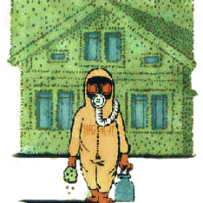Mold and Health

Mold is more than just unsightly; It can be a health problem and cause property damage. The Centers for Disease Control and Prevention say exposure to mold does not always present a health problem, but concedes that some people are especially sensitive to it. David Straus, a microbiologist and leading mold expert at Texas Tech University, says some molds throw off tiny spores that can be inhaled. These molds also produce mycotoxins that can cause symptoms associated with “sick building syndrome,” such as eye, nose and throat irritation, headaches, and fatigue.
All the experts agree prevention is the key, keep up with regular maintenance by a professional to prevent build up before it can cause a health concern or property damage.
State Farm Insurance and Allstate have stated that mold is the leading cause for insurance rate increases in a number of states, including Florida.
Mycotoxins are chemicals produced by mold, which cause a toxic response in humans if ingested, inhaled, or in contact with skin. Mycotoxins can affect the immune system, nervous system, liver, kidneys, blood and blood clotting. Some mycotoxins are also known carcinogens. Research is being conducted to determine how fungal mycotoxins may contribute to vague health symptoms experienced by those who live in environments with a high fungal load. Many fungi produce mycotoxins, both inside spores and on their surfaces. Killing spores does not disable the toxicity of mycotoxins. In fact, mycotoxins can be present on or in spores, whether the spores are dead or alive. Stopping fungal growth does not stop adverse medical symptoms. Both spores and hyphae can be allergenic and/or toxic.
Under damp conditions, specific species of fungi may produce mycotoxins like some of the following: • Aspergillus versicolor • Penicillium chrysogenum • Penicillium expansum • Stachybotrys chartarum (atra)
Aspergillus and Penicillium, which produce mycotoxins, are often present in homes following a flood or chronic moisture invasion. Stachybotrys chartarum will grow on very wet building materials which contain cellulose and low nitrogen content. Stachybotrys is associated with a very potent mycotoxin. In addition to unusual mycotoxin symptoms, exposure of Stachybotrys to the skin may also cause a rash.
MVOCs, (Microbial Volatile Organic Compounds) are musty, moldy odors associated with fungi. Fungus release MVOCs as gases, as a result of life processes. MVOCs are composed of alcohols, ketones, hydrocarbons, and aromatics. Porous building materials can absorb MVOCs, and release the odors over time. MVOCs may contribute to health effects in humans although valid information on long term or acute effects is lacking. Individuals can consult with their physicians, or allergists to inquire about individual health effects. It has been suggested that the MVOCs carry the mycotoxins during the evaporation process.
Health Effects of Mycotoxins Mycotoxins may cause a variety of short-term as well as long-term adverse health effects. This ranges from immediate toxic response and immune-suppression to the potential long-term carcinogenic effect. Symptoms due to mycotoxins or toxin containing airborne spores (particularly those of Stachybotrys) include dermatitis, recurring cold and flu-like symptoms, burning sore throat, headaches and excessive fatigue, diarrhea, and impaired or altered immune function. The ability of the body to fight off infectious diseases may be weakened resulting in opportunistic infections. Because these symptoms may also be caused by many other diseases, misdiagnoses of mycotoxin exposures are common. There are very few physicians with the experience or expertise in correctly diagnosing mycotoxin exposures or mycotoxicoses. Occupational or building-related exposures to mycotoxins through inhalation are slowly being recognized as a major indoor air quality problem. Generally, removal of causative agents is necessary.
There are a host of fungi that are commonly found in ventilation systems and indoor environments. The Cladosporium and Aspergillus fungi make up 75% of the microbes. These organisms can occur naturally in the exterior environment and enter as spores or active fungi attached to dust particles. HEPA (high efficiency particulate air) filtration of incoming air and a regular program of maintenance and cleaning of ventilation ducts can reduce the levels of molds that may enter and multiply in the indoor environment. Damp areas such as basements and attic areas where water seepage or condensation may occur are prime growing areas for molds. Most will reproduce quickly if the temperature (the ideal temperature range is 68 to 86) and humidity conditions (70% or higher) are right.
The most common hazardous species associated with a water loss belong to the families: Aspergillius, Penicillium, Cladosporium, Mucor, Stachybotrys atra, Absidia, Alternaria, Fusarium and Cryptostroma. The greatest risks are caused by the Aspergillus and Penicillium strains. Various strains of these families of molds have been implicated in being causative agents in asthma, hypersensitivity pneumonitis and pulmonary mycosis.
Many species in the genera Aspergillus, Penicillium and Cladosporium are known to produce mycotoxins. These three groups of fungi are also very common indoors. Other toxigenic fungi frequently found indoors are Alternaria, Trichoderma, Fusarium, Paecilomyces, Chaetomium and Acremonium.
When discussing mycotoxins, species of Aspergillus deserve special attention. Species of Aspergillus produce such well-known toxins as aflatoxins, ochratoxins, and sterigmatoeystin. Aflatoxins that are produced by Aspergillius flavus and Aspparasiticus are detected in stored peanut and grains. Ochratoxins are produced by many species of Aspergillus as well as Penicillium. These fungi grow well on many common building materials soiled and contain higher than normal moisture content.
Allergic Fungal Sinusitis
Allergic fungal sinusitis (infection of the sinus) is a unique, probably under diagnosed condition similar to the lower airway disorder, allergic bronchopulmonary Aspergillosis. Characteristic features of fungal sinusitis are signs or symptoms of chronic sinusitis unresponsive to antibiotic therapy. The sinus contents in patients with fungal sinusitis contain allergic mucin, a thick cheese-like secretion, Charcot-Leyden crystals, and fungal elements. The fungi associated with this condition include Aspergillus, Curvularia, Drechslera, Bipolaris, Exserohilium, Alternaria, Helminthosporium, and Fusarium. (John W. Georgitis, MD, FCCP Professor of Pediatrics Wake Forest University Baptist Medical Center Winston-Salem, North Carolina

